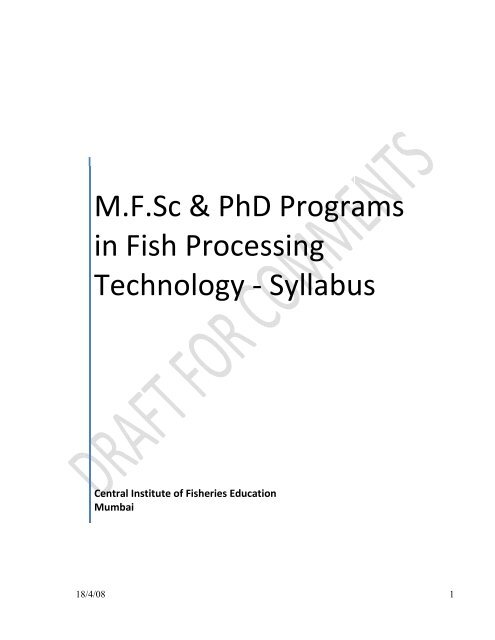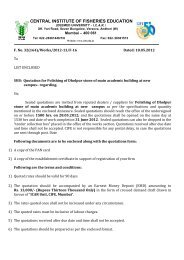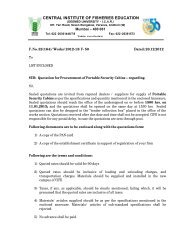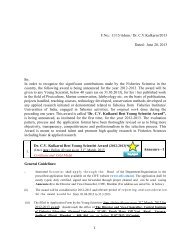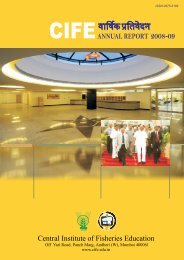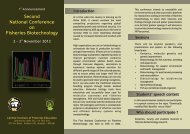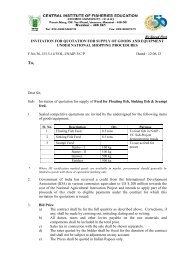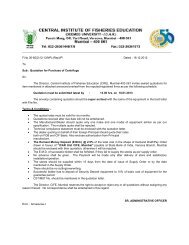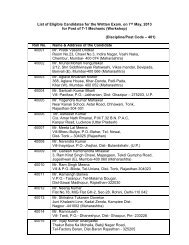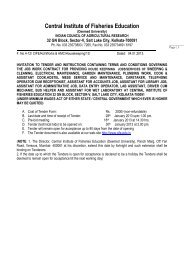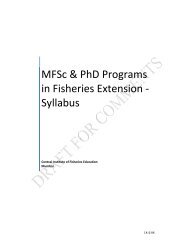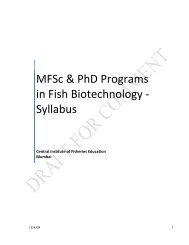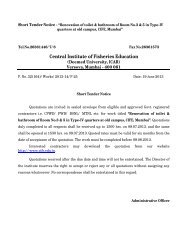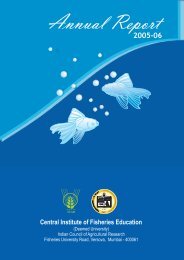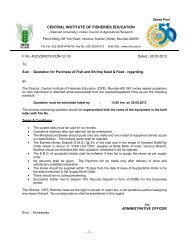Fish Processing Technology MFSc & PhD Syllabus - Central Institute ...
Fish Processing Technology MFSc & PhD Syllabus - Central Institute ...
Fish Processing Technology MFSc & PhD Syllabus - Central Institute ...
Create successful ePaper yourself
Turn your PDF publications into a flip-book with our unique Google optimized e-Paper software.
M.F.Sc & <strong>PhD</strong> Programs<br />
in <strong>Fish</strong> <strong>Processing</strong><br />
<strong>Technology</strong> - <strong>Syllabus</strong><br />
<strong>Central</strong> <strong>Institute</strong> of <strong>Fish</strong>eries Education<br />
Mumbai<br />
18/4/08 1
M.F.Sc. (<strong>Fish</strong> <strong>Processing</strong> <strong>Technology</strong>) Major Courses<br />
Code Course Title Credits<br />
CORE COURSES<br />
1. FPT 501 <strong>Technology</strong> of fish freezing and frozen storage 1+1<br />
2. FPT 502 Thermal <strong>Processing</strong> fishery products 1+1<br />
3. FPT 503 Quality assurance, management and certification 1+1<br />
4. FPT 504 Applied <strong>Fish</strong> Biochemistry 1+1<br />
5. FPT 505 Techniques in Microbiology 1+1<br />
6. FPT 506 Cured, dehydrated and smoked fishery products 1+1<br />
OPTIONAL COURSES<br />
1. FPT 507 Handling, storage and transport of fresh fish 1+1<br />
2. FPT 508 <strong>Technology</strong> of mince based fish products 1+1<br />
3. FPT 509 Additives in <strong>Fish</strong> <strong>Processing</strong> 1+1<br />
4. FPT 510 <strong>Fish</strong>ing technology 2+1<br />
5. FPT 511 Research and Statistical methods 2+1<br />
6. FPT 512 <strong>Fish</strong> by-products, utilization of fishery wastes 1+1<br />
7. FPT 513 Microorganisms of public health significance 1+1<br />
8. FPT 514 Instrumentation in fish quality assessment 1+1<br />
9. FPT 515 Packaging of fish and fishery product 1+1<br />
<strong>PhD</strong> (<strong>Fish</strong> <strong>Processing</strong> <strong>Technology</strong>) Major Courses<br />
Code Course Title Credits<br />
CORE COURSES<br />
1. FPT 701 Biochemical Techniques in <strong>Fish</strong> Analysis 2+1<br />
2. FPT 702 Functional Properties of Proteins from <strong>Fish</strong> and<br />
2+1<br />
Shellfish<br />
3. FPT 703 Quality Management Systems 2+1<br />
OPTIONAL COURSES<br />
1. FPT 707 Lipids of Aquatic Origin 2+1<br />
2. FPT 708 Microbial Hazards in <strong>Fish</strong> <strong>Processing</strong> 2+1<br />
3. FPT 709 Vitamins, minerals, flavour bearing components in 2+1<br />
aquatic organisms<br />
4. FPT 711 Toxins and Contaminants 2+1<br />
5. FPT 712 Nutritional Aspects and Nutrition Labeling 2+1<br />
6. FPT 713 Environmental Impact of <strong>Fish</strong>ery Industries 2+1<br />
7. FPT 714 Specialty products and Value Added products 2+1<br />
18/4/08 2
<strong>MFSc</strong> <strong>Syllabus</strong><br />
Core Courses<br />
<strong>Technology</strong> of fish freezing and frozen storage 1 + 1<br />
Objective:<br />
• To teach students about various aspects of freezing of fish<br />
• To teach chemical, bacterial and sensory changes during freezing<br />
Theory:<br />
Freezing: Structure of water and ice, Influence of solutes on the structure of water and ice,<br />
phase equlibria and freezing curves of pure water and binary solutions, freezing curves for<br />
fish, determination of freezing points from time- temperature plots, calculation of freezing<br />
time, crystallization, nucleation, homogeneous and heterogeneous nucleation, super<br />
cooling, crystal growth, eutectic point, location of ice crystals in tissue, changes during<br />
freezing.<br />
Technological aspects of freezing: Methods of freezing, comparison of various freezing<br />
methods, selection of a freezing method, product processing and packaging, chemical<br />
treatment prior to freezing, antioxidants, cryoprotectants and other additives, theories of<br />
cryoprotection, glazing.<br />
Frozen storage: Physical changes - freezer burn and recrystallisation, different types of<br />
recrystallisation.<br />
Chemical changes in lipids, proteins and nucleotides, freeze denaturation and theories on<br />
denaturation, changes in pH, bacterial changes, sensory changes, texture, taste, odour,<br />
effect of post-mortem condition on sensory qualities.<br />
Water holding capacity, time temperature tolerance, temperature and duration of storage on<br />
quality and shelf life. Arrangements within a cold storage, handling and stacking systems,<br />
space requirement, precautions to reduce temperature increase in a cold storage.<br />
18/4/08 3
Filleting of fish, treatments, glazing, packaging and freezing. <strong>Processing</strong> of prawns, lobster,<br />
squid, cuttle fish, crab etc. for freezing.<br />
Practical:<br />
Filleting of fish, treatments, glazing, packaging, freezing,<br />
<strong>Processing</strong> of Prawns, Lobster, Squid, Cuttle <strong>Fish</strong>, Crab etc. in different styles, Packaging<br />
and Freezing,<br />
Freezing curve, determination of freezing point.<br />
Studies on physical, chemical and sensory changes.<br />
Reference:<br />
• Advances in <strong>Fish</strong> processing <strong>Technology</strong>, Sen D. P., Pub. Allied Publishers Pvt. Ltd.<br />
New Delhi (2005).<br />
• <strong>Fish</strong> <strong>Processing</strong> <strong>Technology</strong> (1992) G. M. Hull. (Ed), Blackie Academic and<br />
Professional, London<br />
• Food Freezing Today,and Tomorrow, Springer - Verlage, London<br />
• Food Refrigeration Processes (1990) By Cleland C Andrew, Elsevier Applied<br />
Sciences, London<br />
• Freezing Effects on Food Quality, Marcel Dekker, Inc. New York<br />
• Govindan, T. K., <strong>Fish</strong> processing <strong>Technology</strong>, Pub. Oxford & IBH Publishing Co.,<br />
New Delhi (1985).<br />
• Low Temperature Preservation of Foods and Living Matter Marcel Dekker, Inc. New<br />
York<br />
• Postharvest <strong>Technology</strong> of fish and fish products. (2001). Balachandran, K. K., Pub.<br />
Daya Publishing House, Delhi,<br />
• Principle of Food Science. Fennema, O. R. (editor), Publ. Marcel Dekker Inc.<br />
NewYark<br />
18/4/08 4
• Principles of Total Quality. (1994) St. Leuie Press, USA.<br />
• Quality and Stability of Frozen Foods, Wiley Intersciece (John Wiley and Sons) New<br />
York<br />
• Text Book of <strong>Fish</strong> <strong>Processing</strong> <strong>Technology</strong>; Gopakumar K. (editor), Pub. ICAR, New<br />
Delhi (2002)<br />
Thermal processing of fish products 1 +1<br />
Objective:<br />
• To teach the students various aspects of thermal / heat processing<br />
• To teach irradiation technology to enhance shelf-life of fish and its effect on fish<br />
quality<br />
• To teach various types of packaging techniques and material<br />
Theory:<br />
Principles of thermal processing. Mechanism of heat transfer: conduction, convection,<br />
radiation and dielectric and microwave heating, unsteady state of transfer, heat resistance<br />
of bacteria and spores, decimal reduction time, thermal death time, "Z" and "F" values, heat<br />
penetration, cold point, can size, shape, contents etc. on heat penetration, determination of<br />
process time. Significance of thermal death curve, graphical, formula, nomogram methods –<br />
F 0 value, cook value, D value, integrated F value and their inter-relationship.<br />
Heat processing and heating equipment,<br />
Classification of foods: low acid, medium acid and acidic foods, absolute sterility, statistical<br />
sterility, commercial sterility, pasteurisation and sterilisation.<br />
Canning process, steps involved, process flow, additives, HTST processing and aseptic<br />
canning, principles and process details, canning machinery and equipment, canning<br />
process for fish/shellfish, value added canned products.<br />
18/4/08 5
Spoilage of canned food, physical, chemical and microbial, Thermobacteriology, death of<br />
bacteria, autosterilisation bacteriology of canned/heat processed fishery products,<br />
examination of cans and seams.<br />
Canning plant location: Practical considerations, canning plant facilities, layout design.<br />
Flexible packing, retort pouch processing of fish and fishery products principles and<br />
techniques. Combination and synergistic effects.<br />
Hurdle technology: Combination with heat, heat and hydrostatic pressure, heat and low pH,<br />
heat and NaCI and nitrite, combination with ionising radiation, irradiation and hydrostatic<br />
pressure, irradiation and NaCI, irradiation and other adjuncts, heat and irradiation,<br />
irradiation and low temperature, low pH and specific acids, low a w and adjuncts.<br />
Irradiation: Radiation sources, units, dose levels radappertization, radicidation, radurization,<br />
effects of irradiation on protein, lipids, vitamins, bacteriological aspects, physical properties,<br />
shelf life.<br />
Practical:<br />
Evaluation of pasteurisation and sterilisation, determination of TDT and F value Examination<br />
of canned foods, can seams, testing sterility, isolation of Bacillus and Clostridium Spp, spore<br />
staining, heat penetration curve and cooling curve, canning operations for different<br />
fish/shellfish products<br />
Double seam profile, Heat Penetration Curve, F 0 Value, Z value, Process time, Canning of<br />
table fishes, Bivavles, Crustaceans in different containers, Operation of over pressure<br />
autoclaves, Canned culinary preparations, Examination of canned fishery products.<br />
Reference:<br />
• A Handbook of Food Packaging (1983) Leonard Hill, London<br />
• Advances in <strong>Fish</strong> processing <strong>Technology</strong>. (2005). Sen D. P., Pub. Allied Publishers<br />
Pvt. Ltd. New Delhi.<br />
• Canned Foods. (1980) Hersom and Hulland, Churchill Livingstone, New York<br />
18/4/08 6
• <strong>Fish</strong> <strong>Processing</strong> <strong>Technology</strong> (1992) G. M. Hull. (Ed), Blackie Academic and<br />
Professional, London<br />
• Food Canning <strong>Technology</strong> (1997) Larousse and Brown Eds., Willey VCH New York<br />
• Food Irradiation (1991) Thorne, S (Ed), Elsevier Applied Science, London<br />
• Food Packaging – Principles and Practices (1993) Marcel Dekker, Inc. New York<br />
• Govindan, T. K., <strong>Fish</strong> processing <strong>Technology</strong>, Pub. Oxford & IBH Publishing Co.,<br />
New Delhi (1985).<br />
• HACCP in meat, poultry and fish processing (1992). Garret, E.S., Hudak Roos, M<br />
and Ward, D.R Advances in meat research series. Vol 1 O.<br />
• Handbook of Food Engineering Practices (1997) Valentus, K.J.,Rotskin, E and Paul<br />
Singh, R CRC press New York<br />
• Heat Transfer and Food Products (1988) Elsevier Applied Science, London<br />
• Introduction to Food engineering (2001) Paul Singh, R, Dennis R Heldman,<br />
Academic Press, London<br />
• Mechanism of Action of Food Proservation Procedures (1989) W. Gould (Ed),<br />
Elsevier Applied Science<br />
• Manual on <strong>Fish</strong> Canning. (1988). Warne, D., FAD <strong>Fish</strong>eries Technical paper 285<br />
• NFPA Laboratory Manual of Food Canners and Processors (1980) AVI. Publishing<br />
Co. Westport, Connecticut<br />
• Novel Food Packaging Tech-niques-(2003} ~f9ress-New~York<br />
• Physical Principles of Food Preservation, (1975) Marcel Dekker Inc. New York<br />
• Postharvest <strong>Technology</strong> of fish and fish products. (2001). Balachandran, K. K., Pub.<br />
Daya Publishing House, Delhi,<br />
18/4/08 7
• Principle of Food Science. Fennema, O. R. (editor), Publ. Marcel Dekker Inc.<br />
NewYark<br />
• Seafood Effect of Technolongy on Nutrition (1990) Pegott, G.M. and Tucker, B.W.<br />
(Eds) Marcel Dekker I nc. New York<br />
• Text Book of <strong>Fish</strong> <strong>Processing</strong> <strong>Technology</strong>; Gopakumar K. (editor), Pub. ICAR, New<br />
Delhi (2002)<br />
• Thermo Bacteriology in Food <strong>Processing</strong> (1973). Stumbo, C.R ,Academic Press,<br />
New York<br />
Quality assurance, management and certification 1 + 1<br />
Objective:<br />
• To teach various aspects of quality assurance system, quality management and<br />
national / international certification system<br />
• To teach factory sanitation and hygiene, water quality and standards<br />
• To teach quality affecting parameters<br />
Theory:<br />
Quality management, total quality concept and application in fish trade. Quality assessment<br />
of fish and fishery products - physical, chemical, organoleptic and microbiological quality<br />
standards.<br />
Inspection and quality assurance: <strong>Fish</strong> inspection in India, process water quality in fishery<br />
industry, product quality, water analysis, treatments, chlorination, ozonisation, UV radiation,<br />
reverse osmosis, techniques to remove pesticides and heavy metals. Sensory evaluation of<br />
fish and fish products, basic aspects, different methods of evaluation, taste panel selection<br />
and constitution, statistical analysis.<br />
Quality problem in fishery products: Good manufacturing practices. HACCP and ISO 9000:<br />
2000 series of quality assurance system, validation and audit. National and international<br />
standards, Codex alimentarius, USFDA and EU regulations for fish export trade, IDP<br />
18/4/08 8
and SAT formations in certification of export worthiness of fish processing units, regulations<br />
for fishing vessels, pre-processing and processing plants, EU regulations. ISO22000:2006<br />
Factory sanitation and hygiene: National and international requirements, SSOP<br />
Water quality and standards, water analysis, purification and treatment of water.<br />
Food laws in India, integrated food law.<br />
Practical:<br />
Evaluation of fish / fishery products for organoleptic, chemical and microbial quality.<br />
Methods for analysis for bacterial quality parameters, chemical parameters and filth.<br />
Evaluation of sanitary conditions in fish processing units.<br />
Analysis of typical hazards. Study of correction and corrective action.<br />
SQC : Introduction, statistical principles involved, process control, control charts, variable<br />
and attribute control charts, Acceptance sampling, basic ideas, sampling by attributes single<br />
and double sampling plants, Basic concepts of decision making.<br />
Familiarization with water quality analysis<br />
Reference:<br />
• Advances in <strong>Fish</strong> processing <strong>Technology</strong>, Sen D. P., Pub. Allied Publishers Pvt. Ltd.<br />
New Delhi (2005).<br />
• Assessment and Management of Seafood Safety and Quality. (2003) Free amino<br />
acids Technical Paper No. 444<br />
• <strong>Fish</strong> <strong>Processing</strong> <strong>Technology</strong> (1992) G. M. Hull. (Ed), Blackie Academic and<br />
Professional, London<br />
• Food borne Disease Handbook. IInd Edn. (2001) Vol.4:Seafood and Environmental<br />
Toxins, Marcel Dekker Inc New York<br />
18/4/08 9
• Handbook of Natural toxins - Vol 3. Marine Toxins and Venom. 1988. Marcel Dekker<br />
Inc. New York<br />
• Handbook of Natural toxins - Vol 4. Bacterial Toxins. 1988. Marcel Dekker Inc. New<br />
York.<br />
• ISO- 9000-3 1995 Springer<br />
• Low Temperature Preservation of Foods and Living Matter Marcel Dekker, Inc. New<br />
York<br />
• Postharvest <strong>Technology</strong> of fish and fish products. (2001). By Balachandran, K. K.,<br />
Pub. Daya Publishing House, Delhi,<br />
• TQM - in New Product Manufacturing. (1992), McGraw Hill Inc. New York 4.<br />
Introduction of Total Quality. (1994) Prentice Hall Inc., USA<br />
• Principles of Total Quality. (1994) St. Leuie Press, USA.<br />
• Seafood toxins 1984. American Chemical Society, Washington, D.C.<br />
• Text Book of <strong>Fish</strong> <strong>Processing</strong> <strong>Technology</strong>; Gopakumar K. (editor), Pub. ICAR, New<br />
Delhi (2002)<br />
Applied <strong>Fish</strong> Biochemistry (1+1)<br />
Objective:<br />
• To teach macro and trace constituents and nutritive value of fish<br />
• To teach toxins and toxic substances and their toxic effects<br />
• To teach various experimental techniques used in food analysis<br />
Theory:<br />
Seafood proteins:<br />
Sarcoplasmic proteins: Classification, enzymes, hydrolases.<br />
18/4/08 10
Oxidoreductases; Other enzymes, pigments, Heme proteins, Myoglobin, Hemocyanins,<br />
parvalbumins, antifreeze proteins.<br />
Myofibrillar proteins: Myosin – isolation, sub-unit composition, stability, gelation, actin,<br />
allergins, tropomyosin, troponins, paramyosin, connectin. Collagen in fish muscle and skin:<br />
location, connective tissue in the muscle, characteristics of seafood collagen, collagen on<br />
the quality of seafoods, gaping.<br />
Functional properties of seafood proteins: Solubility, emulsification, viscosity, water holding,<br />
gelation, texture profile analysis.<br />
Denaturation: At high and low temperatures and kinetics, dissociation / aggregation /<br />
coagulation etc. reversibility, significance to processing and quality.<br />
Hydrolysis and hydrolysates: Process and applications, proteinases.<br />
Non-protein nitrogenous compounds: Free amino acids, peptides.<br />
Nucleotides, Guanidins, urea, quarternary ammonium compounds etc. TMAO and its<br />
decomposition products, demethylase.<br />
Seafood lipids:<br />
Composition and nutritive value, lipid types and their variations, fatty acid composition of fish<br />
liver and body oils, lipid fractionation, triglycerides, phospholipids, non-saponifiables<br />
includinding sterols and vitamins. Polyunsaturated fatty acids, prostaglandins, beneficial<br />
effects on human health, estimation of lipid fractions, auto-oxidation of fatty acids, pro- and<br />
anti-oxidants, oxidation indices, lipid-protein interactions, oxidized lipids-protein interactions<br />
and their impact on quality, rancidity, lipasas and phospholipases.<br />
Macro and trace elements in fish and shellfish; Minerals of nutritional significance, toxic<br />
metals and their harmful effects and metallothionines.<br />
Flavour bearing compounds in fish.<br />
Nucleotides: Post mortem degradation, K-value<br />
Free amino acids, amines, volatile fatty acids, carbonyls, sulphur containing compounds,<br />
carotenoids, isoprenoids.<br />
Biogenic amines, Aflatoxins in cured fish.<br />
Practical:<br />
Molarity, normality, acid-base, redox titration, buffers<br />
Lipids –Fractionation by TLC and other chromatographic techniques<br />
Fatty acid composition by GLC, Amino acid analysis by HPLC<br />
18/4/08 11
Protein purification methods: (NH4)2SO4/solvent precipitation<br />
Ultracentrifugaion, dialysis & ultrafiltration, gel filtration, electrophoresis, PAGE and SDS-<br />
PAGE,<br />
Marine polysaccharides for food use, molecular biology techniques in fish and bacterial<br />
identification, and topical subjects.<br />
Reference:<br />
• Food Analysis Theory and Practice (1994). Pomeranz, Y. and Meloan, C. E., Avi<br />
Publishing Co. Wert port<br />
• Food Protein Chemistry (1984). By Regenstein, J. M. and Regenstein C. E., Academic<br />
Press INC.<br />
• Food Texicology (part A) and Principal & concepts (partB) (1988). By Concon, J.<br />
Marcel Dekker INC, New York<br />
• Instrumental Methods in Food Analysis (1997) By Pare J.R.J. and Belanger J.M.R.<br />
Elsevier, Netherlands<br />
• Morden Methods of Food Analysis (1984). By Stewart K.K. (Ed). Avi Publishing co.<br />
westport<br />
• Mordern Techniques of Testing <strong>Fish</strong> & <strong>Fish</strong>ers Product for Food & Feed (1967). By<br />
Mukundan M.K. Biochemistry & Nutrition & microbiology division<br />
• Nutrition In approach (1967). By Pike R. L. and Brown M.L. Wilcy Eastern Private<br />
Techniques in Microbiology 1+1<br />
Safety in microbiology laboratory – Prevention of contamination, aerosol sampling,<br />
disinfection and evaluation of disinfectants.<br />
Microscopy – bright-field, fluorescence, phase-contrast, dark ground and electron<br />
microscope.<br />
Staining techniques - chemistry and various types.<br />
18/4/08 12
Sterilisation – principles and various physical and chemical methods.<br />
requirements of microorganisms – growth media and different types.<br />
Nutritional<br />
Isolation, enumeration, preservation and maintenance of cultures - growth curve, different<br />
types of cultures, population estimation techniques.<br />
Routine tests for identification of bacteria - morphological, cultural, biochemical and<br />
serological. Anaerobic bacteria - methods of anerobiosis. Basics of mycological and<br />
virological techniques. Introduction to molecular techniques in Microbiology.<br />
Practicals: Microscopic techniques, isolation, enumeration and identification of<br />
microorganisms, serological techniques, anaerobic bacteria, mycological, virological<br />
and molecular techniques.<br />
Cured, dehydrated, smoked fishery products 1 + 1<br />
Objective:<br />
• To teach about various scientific preservation techniques of fish.<br />
• To teach changes during storage of products<br />
Theory:<br />
Free and bound water in foods, water activity and sorption behaviours of foods, storage<br />
characteristics, microbial spoilage, effects of water activity on chemical deterioration,<br />
enzymatic reaction, non-enzymatic browning, lipid oxidation, reaction between lipids and<br />
proteins, dry fish, control of micro-organisms.<br />
Principles of drying and dehydration: Psychometrics, drying calculation, constant rate and<br />
falling rate, drying time in air, moisture transport mechanism, natural drying, solar drying and<br />
mechanical drying. Different types of dryers: tunnel drier, vacuum drier, drum drier, solar<br />
drier etc.<br />
18/4/08 13
Dehydration of fish products: dehydration ratio, precautions to be taken in fish drying;<br />
denaturation of fish protein<br />
Cured fish, use of salt, factors affecting salt uptake by fish, lean and fatty fish, whole, gutted<br />
or split open, type and size of salt crystals, source of salts and impurities in salts, effect of<br />
impurities on salt penetration, temperature of salting.<br />
Spoilage of dried / cured fish, physical, chemical and microbiological changes, methods to<br />
prevent / control spoilage, extension of shelf life<br />
Smoke curing, chemistry of smoke, composition and properties, smoking methods: cold and<br />
hot method, use of smoke liquids, production of smoke, type of wood used, methods of<br />
smoke generation, carcinogens in smoke, smoke kilns<br />
Marinades: Principles; processing of cold, cooked and fried marinades, shelf life and<br />
spoilage.<br />
<strong>Fish</strong> and shellfish pickles: production, shelf life<br />
Packaging requirements for dry, cured and fermented products.<br />
Practical:<br />
Preparation of dried, cured and fermented fish products, examination of salt, protein,<br />
moisture in dried / cured products, examination of spoilage of dried / cured fish products,<br />
marinades, pickles, sauce,<br />
Reference:<br />
• Advances in <strong>Fish</strong> processing <strong>Technology</strong>, By Sen D. P., Pub. Allied Publishers Pvt.<br />
Ltd. New Delhi (2005).<br />
• Batters and Breadings in Food <strong>Processing</strong> Karel Kulp and Robert<br />
Loewe(Eds),American Association of Cereal Chemists, Inc.St.Paul,Minnesota 55121-<br />
2097 USA.<br />
• Batter and Breading <strong>Technology</strong>, Darrel R. Sudermanand E. Cunningham(Eds), Ellis<br />
Horwood Limited, Publishers, Chichester, England.<br />
18/4/08 14
• <strong>Fish</strong> <strong>Processing</strong> <strong>Technology</strong> (1992) G. M. Hull. (Ed), Blackie Academic and<br />
Professional, London<br />
• Heat Transfer and Food Products (1988) Elsevier Applied Science, London<br />
• Introduction to Food engineering (2001) Paul Singh, R, Dennis R Heldman,<br />
Academic Press, London<br />
• Manual of processing, packaging and preservation of value added fishery products,<br />
Infofish publication, Infofish, P.O. Box 10893, Kualalampur ,Malaysia<br />
• Natural Antimicrobial Systems and Food Preservation (1994), CAB International<br />
Walligford<br />
• Postharvest <strong>Technology</strong> of fish and fish products. (2001). By Balachandran, K. K.,<br />
Pub. Daya Publishing House, Delhi,<br />
• Principle of Food Science. Fennema, O. R. (editor), Publ. Marcel Dekker Inc.<br />
NewYark<br />
• <strong>Processing</strong> Aquatic Food Products, By Wheaton and Lawson (1985) John Wiley and<br />
Sons New York.<br />
• Text Book of <strong>Fish</strong> <strong>Processing</strong> <strong>Technology</strong>; Gopakumar K. (editor), Pub. ICAR, New<br />
Delhi (2002)<br />
OPTIONAL COURSES<br />
<strong>Fish</strong> by-products and utilization of fishery wastes 1 + 1<br />
Objective:<br />
• To teach students regarding various fish by-products, and utilization of fishery wastes<br />
Theory:<br />
<strong>Fish</strong> meal: Production - dry and wet process, machinery, control of quality of products,<br />
specifications, packaging and storage<br />
<strong>Fish</strong> body and liver oils: Extraction, purification, preservation and storage, industrial and<br />
nutritional applications of fish oils. Vitamin A & D<br />
18/4/08 15
Essential fatty acid functions of fish oils, poly unsaturated fatty acid (PUFA), production of<br />
concentrates of polyunsaturated fatty acids, preparation of fatty alcohol and amides,<br />
Utilisation of shark: <strong>Processing</strong> of shark meat, removal of urea in meat, filleting, curing and<br />
dehydration, extraction of shark liver oil, Vitamin A, D, squalene, ambergris, curing and<br />
tanning of shark skin, shark cartilage<br />
Shrimp waste, crab shell and squilla utilisation: Resources and composition, conventional<br />
uses, feeds and manure, conversion to useful materials like chitin, chitosan, glucosamine<br />
hydrochloride, commercial production, production and use of protein isolates from squilla<br />
and shrimp waste.<br />
<strong>Fish</strong> protein concentrate: Different methods of production, functional properties, different<br />
types of FPC, texturised products.<br />
<strong>Fish</strong> silage: Acid silage and fermented silage, advantages over fish meal, nutritional value of<br />
silage.<br />
<strong>Fish</strong> hydrolysates: Production and utilisation, biochemical composition and importance in<br />
food and nutrition<br />
Miscellaneous by-products: <strong>Fish</strong> maws and isinglass, pearl essence, fertiliser, beche-demer,<br />
processing of snail meat and jelly fish.<br />
Practical:<br />
Preparation of fish meal, FPC, fish oils, chitin, chitosan, glucosamine hydrochloride, fish<br />
maws, isinglass, agar, alginic acid, , glue, pearl essence, fish sauce.<br />
Reference:<br />
• Advances in <strong>Fish</strong> processing <strong>Technology</strong>, Sen D. P., Pub. Allied Publishers Pvt. Ltd.<br />
New Delhi (2005).<br />
• Postharvest <strong>Technology</strong> of fish and fish products. (2001). By Balachandran, K. K.,<br />
Pub. Daya Publishing House, Delhi,<br />
18/4/08 16
• <strong>Fish</strong> <strong>Processing</strong> <strong>Technology</strong> (1992) G. M. Hull. (Ed), Blackie Academic and<br />
Professional, London<br />
• Govindan, T. K., <strong>Fish</strong> processing <strong>Technology</strong>, Pub. Oxford & IBH Publishing Co.,<br />
New Delhi (1985).<br />
• Principle of Food Science. Fennema, O. R. (editor), Publ. Marcel Dekker Inc.<br />
NewYark<br />
• Text Book of <strong>Fish</strong> <strong>Processing</strong> <strong>Technology</strong>; Gopakumar K. (editor), Pub. ICAR, New<br />
Delhi (2002)<br />
• Introduction to <strong>Fish</strong>ery Byproducts (1981) By Barlaw<br />
• <strong>Processing</strong> Aquatic Food Products, By Wheaton and Lawson (1985) John Wiley and<br />
Sons New York<br />
Design, maintenance of fish processing plants and instrumentation 1 + 1<br />
Objective:<br />
• To teach plant design, function and maintenance of fish processing plants and<br />
various measurement techniques<br />
• To teach scientific techniques of effluent treatment<br />
Theory:<br />
a) Design and maintenance of fish processing plants<br />
Plant design: Fundamentals of processing plant design: Site selection, design and<br />
preparation of layout of processing plants - freezing plant, cold storage, canning plant,<br />
dryers etc.<br />
Functions and construction of refrigeration system: Tests and inspection, Operation and<br />
handling, P-H diagram and basic calculation - Application of P-H diagram, size and required<br />
power of compressor, maintenance of refrigerating machine, troubles and causes.<br />
18/4/08 17
Preventive maintenance of machinery and equipment of fish processing plants, IQF,<br />
Canning plant, sausage plant, artificial dryers, smoking chambers etc., safety controls for<br />
freezing and canning plant<br />
Effluent treatment: Legislation and standards of effluent discharge, water pollution control<br />
measures in the food industry, waste water treatment process; dissolved air floatation,<br />
sedimentation, chemical treatment, biological treatment, aeration, carbon adsorption,<br />
granular media filtration and sludge handling. Boilers - Classification and selection of<br />
boilers, Boiler mounting and accessories.<br />
b) Instrumentation<br />
Measurement techniques<br />
Sensors, active and passive sensors, characteristic of sensors for the measurement of<br />
temperature, relative humidity, a w value, gel strength, moisture, freshness, pH, conductivity,<br />
DO, redox potential, salinity, air velocity, solar energy and brine concentration.<br />
Thermometers: Different types of thermometers, characteristics and application.<br />
Instrumentation techniques: General configuration of instrumentation system.<br />
Instrumentation for measurement of a w value, temperature, pH, freshness, gel strength,<br />
salinity, brine concentration<br />
Thermal properties of foods: Calorie, heat loss, heat gain, specific heat, Newton's laws of<br />
cooling, heat transfer, latent heat, laws of fusion, thermal conductors, thermal diffusivity<br />
Practical:<br />
a) Design and Maintenance of <strong>Fish</strong> <strong>Processing</strong> Plants<br />
Operation and maintenance of machinery and equipment for cold storage plant, freezing<br />
plant, canning plant, sausage making, dryers, boilers etc. Assembly of a refrigeration unit<br />
and charging refrigerant.<br />
b) Instrumentation<br />
Measurement of temperature inside cold storage / freezer, fish during freezing and thawing.<br />
18/4/08 18
Estimation of Gel strength.<br />
Measurement of solar radiation, air velocity, air temperature. Measurement of salinity,<br />
conductivity, pH.<br />
Estimation of water activity.<br />
Reference:<br />
• Advances in <strong>Fish</strong> processing <strong>Technology</strong>, Sen D. P., Pub. Allied Publishers Pvt. Ltd.<br />
New Delhi (2005).<br />
• <strong>Fish</strong> <strong>Processing</strong> <strong>Technology</strong> (1992) G. M. Hull. (Ed), Blackie Academic and<br />
Professional, London<br />
• Principle of Food Science. Fennema, O. R. (editor), Publ. Marcel Dekker Inc.<br />
NewYark<br />
Microorganisms of public health significance 1+1<br />
Objective:<br />
• To teach detail about microorganisms of public health significance<br />
• To teach regarding food-born diseases and their prevention<br />
• To teach food causing bacteria, virus and parasites.<br />
Theory:<br />
Infection and immunity, microbial food poisoning, bacteria of public health significance in<br />
fish I fishery products I environments - Salmonella, Clostridia, Staphylococcus, E. coli,<br />
Streptococcus, Vibrio, Aeromonas, Listeria, Yersinia, Bacillus. Laboratory techniques for<br />
detection and identification of food poisoning bacteria. Mycotoxins in cured fish.<br />
Food-borne bacterial infections.. Food infections by Salmonella, Clostridium perfringens,<br />
Vibrio parahaemoliticus, Enteropathogenic E. coli, Aeromonas hydrophila etc., the nature of<br />
causative agent, its source, incidence, foods involved, the diseases, conditions for outbreak<br />
and prevention. The etiology of diseases: Conditions for outbreak & prevention<br />
18/4/08 19
Botulism and staphylococcal food poisoning, organism responsible and their origin, growth<br />
and toxin production, nature of toxins, incidence of poisoning, foods involved.<br />
Food borne non-bacterial infections and intoxications: Aflatoxins, patulin, ochratoxin and<br />
other fungal toxins found in food, toxin producer, source, nature of toxin, toxicity and<br />
significance in foods.<br />
Virus and some parasites found in foods.<br />
Practical:<br />
Laboratory techniques to detect and identify pathogens in fish - E.coli, Staphylococcus<br />
aureus, Streptococus faecalis, Clostridium perfrigens, Clostridium botulinum, Salmonella,<br />
Listeria, Vibrio cholera, Vibrio parabaemolyticus, V. vulnificus, Animal bio-assay of bacterial<br />
toxins.<br />
Reference:<br />
• Food Borne Pathogens Varnam & Evans<br />
• Food Borne Disease Handbook. IInd Edn. (2001) Vol.4:Seafood and Environmental<br />
Toxins, Marcel Dekker Inc New York<br />
• Food Borne Infections & Intoxications Reimann & Bryan<br />
• Food Microbiology Fundamentals & Frontiers M.P. Doyle<br />
• General Microbiology Hans H Schelgel<br />
• Handbook of Natural toxins - Vol 3. Marine Toxins and Venom. 1988. Marcel Dekker<br />
Inc. New York<br />
• Handbook of Natural toxins - Vol 4. Bacterial Toxins. 1988. Marcel Dekker Inc. New<br />
York.<br />
• Microbiology Perscott Harvey & Cleim<br />
• Seafood toxins 1984. American Chemical Society, Washington, D.C.<br />
18/4/08 20
<strong>Fish</strong>ing <strong>Technology</strong> 2+1<br />
Objective:<br />
• To impart training in design, fabrication and operation of fishing gears.<br />
• To teach the importance and guidelines regarding code of conduct for responsible<br />
fishing operations and safety at sea.<br />
Theory:<br />
Design, fabrication and operation of various fishing gears: trawls (pelagic and bottom),<br />
purse seine, gillnets, trammelnets, dolnets, FADs (Floating and bottom – artificial reefs),<br />
traps and lines.<br />
Harvesting methods in inland water bodies and their improvisation: Gillnets, castnets, lines,<br />
dragnets, bagnets etc.<br />
Effects of fishing method and on-board handling on fish quality<br />
Destructive and prohibited fishing practices.<br />
By-catch reduction devices: Definition of by-catch, types of by-catch reduction devices and<br />
the principles of operation.<br />
Turtle Excluder Devices: Definition, types of TEDs – soft and hard types, materials used for<br />
construction, maintenance.<br />
Acoustics: Acoustic surveys for fishing, acoustic aids in fishing and acoustic measurements.<br />
Safety at sea: Safety devices – Accidents at sea, mitigation measures. Safety devices -<br />
SART, EPIRB, GMDSS.<br />
Advanced communication Systems – VHF, SSB, Inmarsat System.<br />
Vessel Monitoring Systems (VMS): Importance, uses, role in fisheries management.<br />
Satellite navigation system: GPS – Components of GPS, working, functions, , important<br />
applications of GPS in fisheries and aquaculture.<br />
18/4/08 21
<strong>Fish</strong>ing harbours: Classification, facilities, layout of a typical fishing harbour, stages in the<br />
planning of fishing harbours.<br />
Code of Conduct for Responsible <strong>Fish</strong>eries (CCRF): Articles of CCRF, Elaboration of Article<br />
8: <strong>Fish</strong>ing Operations.<br />
Practical:<br />
Drawing and reading gear designs.<br />
Field visits to fishing harbour and preparation of drawing of its lay out.<br />
Training onboard fishing vessels in fishing techniques, familiarization with navigation and<br />
communication equipments,<br />
Handling and storage of fish.<br />
Study of structure and operation of a fish landing centre.<br />
Study of destructive fishing techniques<br />
<strong>Fish</strong> aggregating devices.<br />
Familiarization with safety devices like SART, EPIRB and GMDSS.<br />
Reference:<br />
• An account of the inland fishing gear and methods of India. (1971). George VC.,<br />
Indian Council of Agricultural Research. Special Bulletion of <strong>Central</strong> <strong>Institute</strong> of<br />
<strong>Fish</strong>eries <strong>Technology</strong>, Ernakulam (9), pp. 68.<br />
• Calculations for fishing gear designs, (1986) Fridman, A.L., FAO <strong>Fish</strong>ing manual,<br />
<strong>Fish</strong>ing News Books, Ltd., Farnham, 264 p.<br />
• Commercial fishing methods-an introduction to vessels and gear, (1996).<br />
Sanisbury, J.C., <strong>Fish</strong>ing News Books Ltd., Farnham, 352 p.<br />
• Course manual in <strong>Fish</strong>ing <strong>Technology</strong>, (1988). Shenoy, Latha., CIFE, Mumbai, 95 p.<br />
18/4/08 22
• <strong>Fish</strong> catching methods of the world. (1984). Brandt. A.V., <strong>Fish</strong>ing news books Ltd.,<br />
London: 432 p.<br />
• <strong>Fish</strong>eries acoustics, <strong>Fish</strong> and <strong>Fish</strong>eries Series 5, (1992) MacLennan, D.N. and<br />
Simmonds, E.j., Chapman and Hall, London, 323 p.<br />
• <strong>Fish</strong>erman’s workbook, (1990), Prado, J., <strong>Fish</strong>ing News Books, Blackwell Scientific<br />
publications Ltd., Osney Mead, Oxford, 192 p<br />
• <strong>Fish</strong>ing gear and craft technology. (2001). Sreekrishna, Y. and Shenoy Latha.,<br />
Indian Council of Agricultural Research, New Delhi, 342 p.<br />
• <strong>Fish</strong>ing operations, (1996). FAO Training guidelines for responsible fisheries No. 1,<br />
FAO, Rome, 26 p.<br />
• Modern <strong>Fish</strong>ing Gear <strong>Technology</strong>, (2000) Hameed, M.S. and Boopendranath, M.R.,<br />
Daya Publishing House, Delhi:186 p.<br />
Handling, storage and transport of fresh fish 1 +1<br />
Objective:<br />
• To teach scientific techniques handling, storage and transport of fresh fish<br />
• To teach various post harvest changes during chill storage of fish.<br />
Theory:<br />
Structure of fish myosystems, Postmortem changes - Structural and chemical<br />
<strong>Fish</strong> as raw material for processing: Body structure, physical properties, shape, specific<br />
weight, bulk weight, angle of slip, weight composition.<br />
Factors affecting quality of fresh fish: intrinsic and extrinsic factors.<br />
Handling of fish onboard fishing vessels, Unit operations<br />
Unloading fish, <strong>Fish</strong> pumps<br />
18/4/08 23
Post-harvest <strong>Fish</strong>ery losses, Methods to reduce losses<br />
Handling of fish in landing centres, defects and modifications needed<br />
Chill storage of fish: Heat load calculation, storage methods. insulated boxes and insulation<br />
thickness, different types of ice, physical, chemical, microbiological and sensory changes<br />
during chill storage, iced storage shelf life, cold shock, physical, chemical and sensory<br />
methods of analysis.<br />
Different types of ice and their manufacture, Flow ice<br />
Sous-vide technology<br />
Melanosis and its prevention, discolouration in aquatic products, non- enzymatic browning<br />
Depuration of bivalves<br />
Modified Atmosphere Packaging<br />
Transportation: Live fish/shell fish, Transportation of raw fish to local markets and<br />
processing centres, Improvements needed in transportation, Refrigerated transport<br />
systems, Classification of transport vehicles, Cold chain.<br />
Practical:<br />
Chill storage studies: Chemical, physical and sensory analysis, determination of shelf life<br />
Handling of fish, bivalves, prawns, mollusks<br />
Depuration, treatment with chemicals, evaluation of freshness of fish.<br />
Reference:<br />
• Advances in <strong>Fish</strong> processing <strong>Technology</strong>, Sen D. P., Pub. Allied Publishers Pvt. Ltd.<br />
New Delhi (2005).<br />
• Assessment and Management of Seafood Safety and Quality. (2003) Free amino<br />
acids. FAO Technical Paper No. 444<br />
18/4/08 24
• <strong>Fish</strong> <strong>Processing</strong> <strong>Technology</strong> (1992) G. M. Hull. (Ed), Blackie Academic and<br />
Professional, London<br />
• Food Storage Stability, CRC Press, New York<br />
• Food Refrigeration Processes (1990) By Cleland C Andrew, Elsevier Applied<br />
Sciences, London<br />
• Freezing Effects on Food Quality, Marcel Dekker, Inc. New York<br />
• Govindan, T. K., <strong>Fish</strong> processing <strong>Technology</strong>, Pub. Oxford & IBH Publishing Co.,<br />
New Delhi (1985).<br />
• Low Temperature Preservation of Foods and Living Matter Marcel Dekker, Inc. New<br />
York<br />
• Post-harvest <strong>Technology</strong> of fish and fish products. (2001). Balachandran, K. K., Pub.<br />
Daya Publishing House, Delhi,<br />
• Principle of Food Science. Fennema, O. R. (editor), Publ. Marcel Dekker Inc.<br />
NewYark<br />
• Principles of Total Quality. (1994) St. Leuie Press, USA.<br />
• Text Book of <strong>Fish</strong> <strong>Processing</strong> <strong>Technology</strong>; Gopakumar K. (editor), Pub. ICAR, New<br />
Delhi (2002)<br />
<strong>Technology</strong> of mince based fish products 1+1<br />
Composition of muscle proteins in fish and their role in emulsification and elasticity<br />
formation<br />
Factors influencing denaturation of muscle proteins and their theories.<br />
testing the protein denaturation<br />
Methods of<br />
Factors influencing elasticity formation and theories of gel formation. Minced meat from<br />
different varieties of fresh and marine water fishes.<br />
18/4/08 25
Improvement of colour of meat by bleaching and certain additives. Use of antidenaturants<br />
to prevent and denaturation of proteins of fish mince during storage.<br />
Changes in meat during mincing and mixing operations and cooking and setting<br />
phenomena.<br />
<strong>Technology</strong> of processing and preservation of gel forming fish flour (AFPP), its property<br />
and utilisation. Unit operations in analog product preparation- Crab sticks analogs,<br />
moulded lobsters and crabs<br />
Battered and breaded products<br />
Use of emulsifiers, binders, seasonings, spices, antioxidants, smoke extract,<br />
Preservatives, natural and artificial casings, nitrites and nitrates. Fortification of fish<br />
products with vitamins and minerals. Quality standards and recent developments.<br />
Practicals: Measurement of viscosity of fish proteins by Ostwald viscometer, effect<br />
of water washing on the quality of meat, colour fixation of red colour meat and estimation<br />
of nitrite. Studies on setting of fish meat. Estimation of starch in the final paste product.<br />
Fundamentals of controlled stress Rheometer. Effect of two stage heating of fish sol on<br />
gel strength.<br />
ADDITIVES IN FISH PROCESSING 1+1<br />
Objectives :<br />
• To familiarize use of different additives, their effects, levels and detection.<br />
Theory<br />
Introduction to food additives-definition-technical benefits of food additives-intentional<br />
and incidental additives.<br />
Relationship of great revolutions in history to the development of food additives –<br />
Agricultural Revolution-Industrial revolutions – urbanization. Basic uses of food<br />
additives.<br />
18/4/08 26
Intentional additives – use of specific nutrients as food additives – Requirements and<br />
considerations – minerals. Vitamins, amino acids and nutrient concentrates as<br />
additives.<br />
Policy considerations in the use of food additives. Flavours and colour as additives.<br />
Antioxidants – Mechanism of antioxidants; commercial antioxidants and selections.<br />
Analytical methods for antioxidants.<br />
Acidulants in food processing; Sequestrants in food processing; Polyphosphates in<br />
food processing; Starch as an additive; Incidental additives.<br />
Practicals<br />
Determination of food additives such as preservatives, antioxidants, curing agents,<br />
chelating agents, acidulants and phosphates in various food products. Detection of<br />
certain intentional and unintentional food additives in foods.<br />
PACKAGING TECHNOLOGY FOR FISH AND FISHERY PRODUCTS 1+1<br />
Objectives :<br />
• To acquaint with different packaging materials, their appropriate use and benefits<br />
Theory:<br />
Food packaging, its purposes and procedures; technological aspects of<br />
packaging fishery products; packing of fresh and frozen fish for consumers; packaging<br />
for transport, shipping and institutional supplies; packaging standards for domestic and<br />
international trade.<br />
Packaging materials; basic films and laminates, their manufacture and<br />
identification; resistance of packaging materials, causes and remedial measures;<br />
development of protective packaging for fishery products; methods of testing for<br />
packaging materials for their physical properties; containers and their testing and<br />
18/4/08 27
evaluation; package designs; resistance of packages to hazards in handling; transport<br />
and storage.<br />
Labelling and printing of packaging materials.<br />
Practicals: Assessment of quality parameters such as moisture permeability, grease<br />
resistance, thickness/guage of basic plastic films and laminates.<br />
Quality assessment of paper and board and the products prepared from them.<br />
Evaluation of packages with regard to the resistance to handling, transportation and<br />
storage.<br />
<strong>PhD</strong> <strong>Syllabus</strong><br />
CORE COURSES<br />
Biochemical Techniques in <strong>Fish</strong> Analysis 2 + 1<br />
Objective:<br />
• To teach detail about various biochemical techniques in fish analysis<br />
Theory:<br />
General principles of separation of micro and macro molecules, selection of appropriate<br />
tools for analysis of fish samples. Outlines of common techniques involved in biochemical<br />
analysis.<br />
Centrifugation techniques: types of centrifugation, concept of Svedberg unit, analytical<br />
ultracentrifuge.<br />
Filtration technique: different types of filtration, types of filters and means of using them.<br />
Spectroscopic techniques: Principles, UV-Visible and IR spectroscopy, spectro-fluorimetry,<br />
18/4/08 28
flame photometry, atomic absorption spectrophotometry, ICP- AES, mass spectrometer<br />
Electrophoretic techniques :<br />
General principles. Classification, Paper electrophoresis,<br />
Native and reduced PAGE, IEF, capillary electrophoresis, 2D Gel electrophoresis.<br />
Chromatographic Techniques : General principle, types of chromatography - adsorption,<br />
partition, ion-exchange, molecular sieve, affinity, Gas chromatography, thin layer<br />
chromatography.<br />
High performance Liquid chromatography, LC MS-MS: Theory and instrumentation.<br />
Practical<br />
Isolation of proteins: sarcoplasmic, myofibrillar, and stromal.<br />
Estimation of proteins : Biuret, Lowry and Dye binding technique.<br />
Amino acid analysis, non-protein nitrogen.<br />
Extraction and estimation of lipids: Measurement of oxidation and hydrolysis of lipids, Fatty<br />
acid profile.<br />
Minerals and heavy metals: Estimation by Atomic Absorption Spectroscopy and flame<br />
photometer.<br />
HPLC- determination of histamine<br />
Demonstration of GC-MS-MS,<br />
Separation of protein by electrophoresis<br />
Reference<br />
1. Introductive Spectroscopy, (1979) Pavia Lampman, Kriz Saunder College Publishers,<br />
2. Mass Spectrometry in Biological Sciences (1996) A.C. Burlingame & S.P. Carr<br />
3. Introduction to Analytical Gas Chromatography (1981), J.A, Peary, Marcel Dekker Inc. 4,<br />
Analytical Instrumentation Handbook (1997), G.W.Ewing, Marcel Dekker Inc.<br />
5. Analysis of Food for nutrition labeling & Hazard contaminants (1995), I.J. Jean & W.J.<br />
Ikim, Marcel Dekker Inc -<br />
6. Practical Biochemistry - Principles & Techniques (2000) Keith Wilson &John Walker<br />
Cambridge University Press<br />
18/4/08 29
7. Mass Spectrometry of Biological materials (1988) B.S.Larsen & C.N. McEwen, Marcel<br />
Dekker Inc<br />
Functional properties of proteins from fish and shellfish 2+1<br />
Objective:<br />
To teach students on biochemical properties that are known to affect product properties.<br />
Theory:<br />
Definition of functional properties and their importance in proteins from fish.<br />
Typical<br />
functional<br />
properties of proteins in food system.<br />
Protein structure and function:<br />
Protein folding and non-covalent forces stabilizing protein<br />
structure with special reference to hydrophobic interactions. Free energy and entropy<br />
concept in relation to hydrophobic interaction. Surface hydrophobicity and its relation to<br />
functional properties. Estimation of surface hydrophobicity and total hydrophobicity.<br />
Solubulity and water sorption of proteins: Factors affecting protein hydration. Viscosity in<br />
relation to protein hydration: Methods of estimating viscosity.<br />
Gelation : Definition of gel, mechanism of formation of gel, factors affecting the gel<br />
formation. Evaluation of gelling capacity- thermal, rheological and microscopy.<br />
Surfactant properties: emulsifying and foaming, Importance of emulsifying properties of<br />
proteins. Theoretical concept of emulsion capacity and stability. Interfacial properties,<br />
adsorption from solution. Methods of estimating surface tension.<br />
18/4/08 30
Emulsion instability: Creaming, sedimentation, aggregation vs Brownian aggregation.<br />
DLVO theory, microemulsions. Methods for estimation of emulsion capacity and stability.<br />
Macromoleculear absorption and different stages of foaming. Foam stability in relation to<br />
proteins structure. Foaming ability of different protein systems with case studies.<br />
Denaturation and functionality: Changes in functional properties of proteins as affected by<br />
icing, freezing, drying, salting and heating.<br />
Modification of proteins for improving<br />
functionality- Succinylation and acetylation procedures.<br />
Practicals<br />
Evaluation of different functional properties like water absorption, fat absorption,, gelling,<br />
emulsification capacity and stability of fish/shell fish proteins. Effect of pH, temperature and<br />
ionic strength on various functional properties. Prediction of functional properties using<br />
model compounds.<br />
Quality Management System (2+1)<br />
Objective:<br />
• To teach different aspects of quality management system and evaluation techniques<br />
for seafood<br />
• To teach Seafood Quality Assurance and Quality Assurance Systems<br />
Theory<br />
Quality Management Systems: The concept of total quality management. The principles of<br />
TQM. Zero defect planning, Quality circle, Quality link, Quality culture. Statistical Quality<br />
Control. Quality as related to preprocess handling, transportation, processing and storage.<br />
Quality evaluation techniques for seafood: Physical, chemical. bacteriological and<br />
Instrumental methods of quality evaluation. Sensory evaluation.<br />
18/4/08 31
Quality standards: National and International – Codex, USFDA, EU norms, ISO, BIS etc.<br />
standards for fish and fishery products.<br />
Seafood Quality Assurance and Quality Assurance Systems: Good Manufacturing (GMP)<br />
and Good Hygiene Practices (GHP) -Codex guidelines. The concept of HACCP in seafood<br />
safety. HACCP team Management role and CCPs and implementation procedure for<br />
HACCP- ISO 22000 FSMS. ISO 9000 series of standards. Cold schedule and hotschedule<br />
for handling perishable commodities.<br />
Validation of methods for quality assurance- Method selection, Quality check, inter-lab<br />
comparision, proficiency testing. Primary standards. Reference standards. Reference<br />
material (RM), Certified Reference Material (CRM) and Standard Reference Material (SRM),<br />
Uncertainty and Calculation of Uncertainty of Measurements<br />
Sample Accountability: Sampling plan -probability sampling and non- probability sampling..<br />
Practical:<br />
Developing flow charts and exercises in identification of hazards- preparation of hazard<br />
analysis worksheet, plan form and corrective action procedures in processing of fish.<br />
Analysis of typical hazards, study of correction and corrective action. Detection and<br />
estimation of important toxic chemicals in food, quality defects.<br />
Reference<br />
1. Assessment and Management of Seafood Safety and Quality. (2003) FAO<br />
Technical Paper No. 444<br />
2. Principles of Total Quality. (1994) St. Leuie Press, USA.<br />
3. TQM - in New Product Manufacturing. (1992), McGraw Hill Inc. New York 4. Introduction<br />
of Total Quality. (1994) Prentice Hall Inc., USA<br />
5. ISO- 9000-3 1995 Springer<br />
6. Food Borne Disease Handbook. (2001) Marcel Dekker.<br />
OPTIONAL COURSES<br />
18/4/08 32
Lipids of Aquatic Origin 2+1<br />
Objective:<br />
• To teach aquatic originated lipids, their metabolic activities and biological significance<br />
Theory:<br />
Lipid classification: Triglycerides, Phospholipids, steroids and other lipids. Lipid micelles and<br />
bilayer.<br />
Fatty acids : Classification, stereochemistry, nutritional significance of fatty acids<br />
Source of lipids : Biosynthesis of lipids, lipid metabolism including that of phospholipids,<br />
typical properties of marine lipids.<br />
Lipids in Biological membranes : Membrane proteins, lipoproteins, transport across<br />
membranes.<br />
Lipid metabolism: fatty acid oxidation, ketone bodies, lipid biosynthesis, regulation of<br />
cholesterol metabolism. Biological significance of marine lipids. Ether lipids and<br />
Eicosanoids- their significance.<br />
Modern analytical techniques employed in lipid chemistry. Methods of extracting polyunsaturated<br />
fatty acids<br />
Practical<br />
Extraction and fractionation of lipids. Fatty acid composition of different lipid fractions.<br />
Evaluation of oxidation product of fish lipid during processing and storage.<br />
Reference<br />
1. Biochemistry, Zybey<br />
2. Fundamentals of Biochemistry (1998) : DVoet, J.G. Voet & C.D. Praff, John Weily<br />
Intersicence,<br />
3. Food Lipids, CC. Akoh & D.B. Min, 1998, Marcel Dekker Inc<br />
4. Nutrition (2001), Paul Jnsel, R.E. Turna & D.Ross, Jones & Bartlet Publishers<br />
18/4/08 33
5. Food Biochemistry & Nutritional Value (1987), David S. Simpson, Longman Scientific &<br />
Technical<br />
Microbial Hazards in <strong>Fish</strong> <strong>Processing</strong> (2+1)<br />
Objective:<br />
• To teach various microbiological related hazards in fish processing.<br />
Theory:<br />
Public health microbiology- Food borne pathogens : Salmonella, Shigella, Enteropathogenic<br />
E. coli, Clostridium botulinum, Listeria monocytogenes, Staph aureus and Vibrio<br />
cholerae, V. parahemolyticus. Emerging food-borne pathogens. Water- borne, Air-borne<br />
and food-borne diseases.<br />
Microbial virulence- infectious diseases. Virulence.<br />
Microbial toxin production-opportunists and true pathogens<br />
Methods for Detection : Rapid detection and indirect detection methods of pathogens and<br />
parasites. Method validation.<br />
Antimicrobial systems and food preservation: ecological concepts: Lactoperoxidase. Nisin,<br />
Lysozyme, Bacteriocins.<br />
Norms for using antimicrobial systems in food processing and preservation. Food Safety,<br />
Risk analysis. Potential health hazards and risks associated with fish products.<br />
Packaging and modified atmosphere on the microbiology and shelf life of fishery products.<br />
Predictive modeling in quality and safety assurance of fishery products.<br />
Practical<br />
Antibiotic assay, sensitivity tests, evaluation of antibacterial properties. Analysis of fish<br />
product constituents. MIC, MCC, Methods for Risk analysis of seafood.<br />
18/4/08 34
Reference<br />
1. Food Borne Bacterial Pathogens<br />
2. Food Borne Infections & Intoxications Reimann & Bryan<br />
3. Food Microbiology Fundamentals & Frontiers M.P. Doyle<br />
Colour and flavour bearing constituents of aquatic organisms (2+1)<br />
Objective<br />
• Compounds responsible for flavor and colour of fish and shellfish.<br />
Theory<br />
Vitamins, Minerals, Pigments, Flavour bearing constituents and other Components in<br />
Aquatic Organisms<br />
Vitamins: Metabolic functions of vitamins, water soluble and fat soluble vitamins<br />
Vitamins from sea food<br />
Minerals: Role of trace elements in metabolism, trace elements of sea food, toxic heavy<br />
metals in sea food.<br />
Pigments and flavour bearing compounds of aquatic origin, chemistry, biochemical role,<br />
changes during processing of seafood.<br />
Metabolic functions of hormones<br />
Nucleoprotein, nucleic acids, nucleotides, nucleosides.<br />
Practicals<br />
Modern methods for analysis of vitamins, minerals and nucleic acids<br />
Organoleptic evaluation of flavours and pigments<br />
Extraction of flavours and pigments and evaluation<br />
18/4/08 35
Toxins and contaminants (2+1)<br />
Objective:<br />
• To teach about various types of toxins and contaminants and their tolerance limit<br />
• To teach various analytical methods to estimate toxins and contaminants<br />
Theory:<br />
Public health problems due to food borne contaminants<br />
Factors contributing to outbreaks of food poisoning<br />
Aflatoxins in fishery products. PAH in smoked fish. Biogenic amines and its significance to<br />
human health, Different types of marine bio-toxins such as Ciguatoxin, Paralytic shellfish<br />
toxins Diarrhetic shell fish toxins, DSP toxins, Scomberotoxins, Brevitoxins, etc. Symptoms,<br />
treatment, pharmacology, detection,<br />
Overview of toxicity of marine animals.<br />
Analytical methods for different types of marine toxins and its tolerance limits : Stability,<br />
Bioassays, Pharmacology assays, Immunoassays, Instrumental methods.<br />
Contaminants of the Aquatic Environment - Heavy metals (Hg, Cd, Pb, Cr, Ni, As etc.).<br />
Pesticide contaminants : PCB, organochlorine etc., their source, bioaccumulation,<br />
magnification and toxicity. Persistent pollutants. Toxicity Evaluation. Measurement of LC 50<br />
and factors affecting LC 50 , Animal tissue Analysis.<br />
Practical<br />
Analysis of bacterial and fungal toxins<br />
Analysis of heavy metals and common pesticides<br />
Biogenic amine estimation<br />
Estimation of LC 50<br />
Reference<br />
1. Food borne Disease Handbook. IInd Edn. (2001) Vol.4:Seafood and Environmental<br />
Toxins, Marcel Dekker Inc New York<br />
18/4/08 36
2. Seafood toxins 1984. American Chemical Society, Washington, D.C.<br />
3. Handbook of Natural toxins - Vol 3. Marine Toxins and Venom. 1988. Marcel Dekker Inc.<br />
New York<br />
4. Handbook of Natural toxins - Vol 4. Bacterial Toxins. 1988. Marcel Dekker Inc. New York.<br />
Labeling of fish and fishery products (2 +1)<br />
Objective<br />
• Labeling of different products, guidelines and enforcement.<br />
Theory<br />
Labeling requirements - national and international, legislation on labeling.<br />
Labeling for product traceability,<br />
Components of traceability code – nutrition facts and nutrition labeling, specific<br />
requirements of nutrition labeling, food meant for specific age groups and convalescing<br />
people.<br />
Serving size, calculation of nutrition facts based on nutrient composition and serving size.<br />
Type of labeling for organic foods specific foods like organic foods, GM foods, irradiated<br />
foods, vegetarian and non vegetarian foods.<br />
Label design specification – size, colour,<br />
Major nutrients Minor nutrients, Essential nutrients, Function (or note) of nutrients -<br />
(providing energy, tissue building) Nutritional research - Nutritional aspects of fish proteins,<br />
lipids, vitamins and free minerals Functional foods/ Neutraceuticals for health, Effect of food<br />
processing on nutritive values of foods. Antinutritional factors, Nutrition labeling, (Energy<br />
value of foods)<br />
Practical<br />
Analysis of major and minor nutrients, calculation of nutrition facts, preparation of labels for<br />
18/4/08 37
typical food items.<br />
Analysis for total calorie, calorific value of fats, protein and carbohydrates.<br />
PER, BV, NPU analysis of different products.<br />
Reference<br />
1. Introduction to Clinical Nutrition & Nutritional Labelling (1998), Viswanathan Seshadri<br />
Marcel Dekker Inc.<br />
2. Nutrition (2001), Paul Jnsel, R.E. Turna & D.Ross, Jones & Bartlet Publishers<br />
3. Food Biochemistry & Nutritional Value (1987), David S. Simpson, Longman Scientific &<br />
Technical<br />
Environmental Impacts of <strong>Fish</strong>eries Industries 2+1<br />
Objective:<br />
• To teach different aspects of Environmental Management Systems in fisheries<br />
industry<br />
Theory<br />
Environmental Management Systems: Environmental issues, (Ozone depletion, global<br />
warming etc.) pollution, long term ecosystem degradation etc in aquaculture and<br />
processing industries.<br />
Environmental impact assessment studies of fisheries industry and control measures,<br />
Sources of environmental concerns (Physical, Chemical and Microbiological).<br />
Techniques for the identification of environmental aspects. IS/ISO 14000 and its relevance<br />
to Environmental Management System in fisheries industry: Background, Policy and<br />
Planning, Implementation, Checking and Review, International and European Laws for<br />
Environmental Protection, National Environmental Laws.<br />
Practical<br />
Composition analysis of fish processing waste, analysis of pollution aspects of solid and<br />
liquid wastes – bacterial load, TDS, BOD, COD, pH, temperature, oil and grease . Resident<br />
18/4/08 38
time analysis for processing waste at the site of disposal.<br />
Reference<br />
1. Bureau of Indian Standards: IS/ISO 14000:1996 on Environmental Management System<br />
2. US-EPA 2000, Manual of Chemical Methods - Second Edition<br />
3. Process Engineering for Pollution Control and Waste Minimization 1994. Ed.<br />
Donald L. Wise Pub!. By Marcel Dekker.<br />
4. APHA 1998 Standard methods for Examination of water and waste water Ed.<br />
Cesceri, L.S.<br />
5. Manual of Environmental Microbiology, Second Edition 2002, Ed. Hurst C., J.<br />
ASM Press<br />
<strong>Fish</strong>ery by-products, specialty products and value added products (2+1)<br />
Objectives<br />
• To teach students the preparation of products from low cost fish.<br />
Theory<br />
Nutritional importance of fish meal and quality requirements -Raw material quality<br />
Nutritional importance of fish oil and methods to impart stability to fish oils on storage,<br />
Unsaponifiables in fish liver oils<br />
Production of fish flour, quality standards and applications.<br />
Different methods of production of FPC, Different types of FPC, and their specifications.<br />
Enzyme hydrolysis of fish, fish hydrolysates, fish peptones, hydrolysates enriched food<br />
beverages<br />
Food flavour from tiny prawns and non-penaeid prawns<br />
Formulation of pet food<br />
18/4/08 39
Chitin, Chitosan and protein extract from shrimp and crab shell and squilla, Quality<br />
requirements and assessment of chitin and chitosan, Application of chitin and chitosan.<br />
Conversion of chitin and chitosan to high value products – glucosamone hydrochloride,<br />
glucosamine sulphate and their use.<br />
Extraction of collagen from fish processing wastes, properties and application. Preparation<br />
of biological membranes using collagen and chitosan for biomedical applications.<br />
Value Added Products: Present market trends, scope of value addition, Types of value<br />
addition, Important value added products.<br />
Coated products – Principles and type of coating, Coating functions, in gradients, Batter<br />
classification, Mechanical properties of batter, Bread crumbs, Flavorings, Seasonings and<br />
Hydrocolloids in coatings, Fat and oils in Coated food and their chemistry,Trouble shooting<br />
techniques for batter and breading systems, Application of batters and breading to seafood.<br />
Practical<br />
Preparation of glucosamine hydrochloride and glucosamine sulphate.<br />
Preparation of isinglass, collagen powder and collagen and chitosan. Preparation of fish<br />
wafers, fish fingers, cutlets etc.<br />
18/4/08 40


